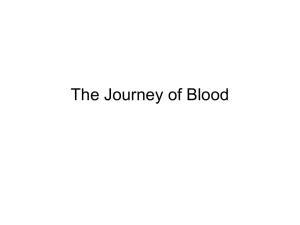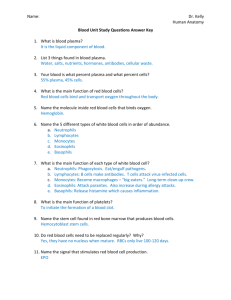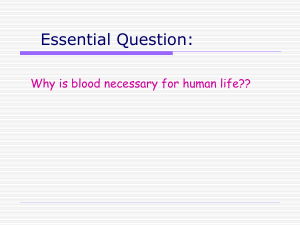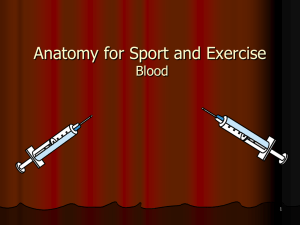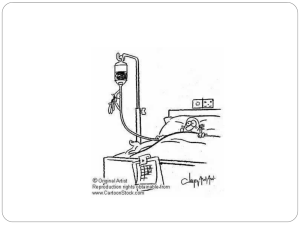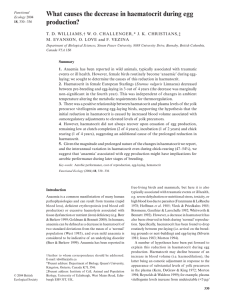Constituents of the Blood - Minerva
advertisement
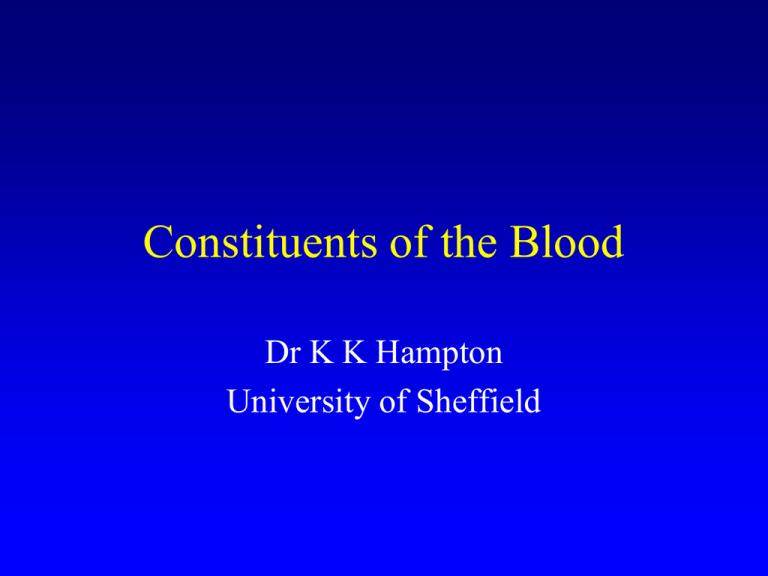
Constituents of the Blood Dr K K Hampton University of Sheffield Blood has two phases • 1) Cellular component Red cells White cells Platelets • 2) Fluid component Plasma Blood • Cellular = 45% • Plasma = 55% Haematocrit 0.45 • In anaemia cellular component decreased acute anaemia = bleeding, also loose plasma haematocrit 0.45, Hb low • chronic anaemia: only loose cells, plasma compensates haematocrit 20%, Hb low Blood • In Polycythaemia cells > plasma haematocrit > 50% Causes: Blood • In Polycythaemia cells > plasma haematocrit > 50% Causes: Erythropoietin Hypoxia (leading to elevated Epo) Haematopoiesis (formation of the blood cells) • Red cells, white cells and platelets in circulation are mature cells, with finite life span red cell = 120 days (make 2 million/sec) white cell = 6 hours platelet 7-10 days red cells and platelets anucleate Haematopoiesis • Precursor cells of mature cells are in the bone marrow Adult = axial skeleton Child = all bones In utero = yolk sac, then liver and spleen • Precursor cells are not found in blood Haematopoiesis • Most primitive cells = stem cells Pluripotent: can replicate and differentiate into RBC, WBC and platelets (stem cells vital for marrow transplantation) • In bone marrow primitive cells proliferate and differentiate into mature cells Haematopoiesis • Hormonal growth factors stimulate cells to proliferate and differentiate • Epo = red cells • G-CSF = white cells • Tpo = platelets Red Cells • Simple cells, no nucleus, no mitochondria • Membrane to enclose Haemoglobin • Enzymes of glycolysis • Haemoglobin to carry oxygen Have a lot of them 4 X 1012/l Have 5 litres of blood Haemoglobin • Carries oxygen from lungs to tissues • Consists of protein, haem, ferrous 2+ ion • Allows oxygen to combine Reversibly with iron in an aqueous environment • Haemoglobin is a tetramer of 2 alpha and 2 beta chains White cells • • • • Neutrophils Monocytes (macrophages) Basophils Eosinophils • Lymphocytes Neutrophils • Phagocytose bacteria and foreign material increased in bacterial infections • Inflammatory cells, release pyrogens that increase temperature • Made in bone marrow from primitive cells called myeloblasts Lymphocytes • Immune cells B cells (bone marrow) = 1 make antibodies 2 memory cells T cells helper cells • Lack = immunodeficiency HIV virus infects CD4 T cells • Make in bone marrow from lymphoblasts Platelets • Small cytoplasmic anucleate cells that block up holes in blood vessels • Determine the bleeding time • Circulate in inactive state • Bind to damaged blood vessel and adhere change shape degranulate aggregate into platelet plug = haemostatic Platelets • Made in bone marrow from cells called megakaryocytes Polyploid cells, cytoplasm buds off to become platelets Platelet number • Normal = 140 – 400 X 109/l • Reduced = thrombocytopenia > 80 = increased bleeding > 20 = spontaneous bleeding • Increased = thrombocytosis Arterial and venous thrombosis Plasma proteins • Soluble and in plasma component • • • • Albumin Carrier proteins for nutrients, hormones Immunoglobulins Coagulation proteins Albumin • • • • Major protein in the plasma Produced in liver Determines oncotic pressure Keeps intravascular fluid in that space Lack of albumin results in oedema Liver disease Nephrotic syndrome Immunoglobulins • Produced by plasma cells = differentiated B lymphocytes • Several classes, IgG, IgM, IgA, IgE • Produced in response to non-self protein antigens • Production of antibodies basis of immunity and vaccination Coagulation proteins • Series of proteins (enzymes) that circulate in inactive form • Function is to make blood clot • Convert soluble fibrinogen into insoluble fibrin polymer Overactivity = thrombosis Failure = bleeding




